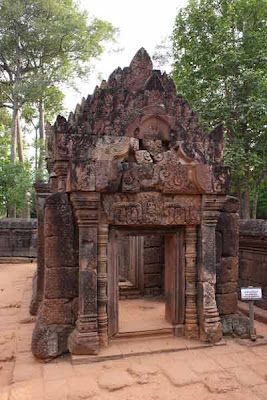Banteay Srei (or Banteay Srey) (Khmer: ប្រាសាទបន្ទាយស្រី) is a 10th century Cambodian temple dedicated to the Hindu god Shiva. Located in the area of Angkor in Cambodia, at 13.5989 N, 103.9628 E, it lies near the hill of Phnom Dei, 25 km (15 miles) north-east of the main group of temples that once belonged to the medieval capitals of Yasodharapura and Angkor Thom.

Banteay Srei is built largely of red sandstone, a medium that lends itself to the elaborate decorative wall carvings which are still observable today. The buildings themselves are miniature in scale, unusually so when measured by the standards of Angkorian construction. These factors have made the temple extremely popular with tourists, and have led to its being widely praised as a "precious gem", or the "jewel of Khmer art.
Consecrated in 967 A.D., Banteay Srei was the only major temple at Angkor not built by a monarch; its construction is credited to a courtier named Yajnavaraha, who served as a counsellor to king Rajendravarman. The foundational stela says that Yajnavaraha was a scholar and philanthropist who helped those who suffered from illness, injustice, or poverty. Originally, the temple was surrounded by a town called Isvarapura.
The temple's modern name, Banteay Srei — citadel of the women, or citadel of beauty — is probably related to the intricacy of the bas relief carvings found on the walls and the tiny dimensions of the buildings themselves.[5] Some have speculated that it relates to the many devatas carved into the walls of the buildings
Banteay Srei was subject to further expansion and rebuilding work in the eleventh century. At some point it came under the control of the king and had its original dedication changed; an inscription of the early twelfth century records the temple being given to the priest Divarakapandita and being rededicated to Shiva. It remained in use at least until the fourteenth century.
The temple was rediscovered only in 1914, and was the subject of a celebrated case of art theft when André Malraux stole four devatas in 1923 (he was soon arrested and the figures returned). The incident stimulated interest in the site, which was cleared the following year, and in the 1930s Banteay Srei was restored in the first important use of anastylosis at Angkor.
Banteay Srei is built largely of a hard red sandstone that can be carved like wood. Brick and laterite were used only for the enclosure walls and some structural elements. The temple is known for the beauty of its sandstone lintels and pediments.
Like most Khmer temples, Banteay Srei is oriented towards the east. It consists of three concentric rectangular enclosures constructed on an east-west axis. A causeway stituated on the axis leads from an outer gopura, or gate, to the third or outermost of the three enclosures. The inner enclosure contains the sanctuary, consisting of an entrance chamber and three towers, as well as two buildings conventionally referred to as libraries.
The third enclosure is 95 by 110 m; it is surrounded by a laterite wall breached by gopuras at the eastern and western ends. Neither pediment of the eastern gopura is in situ.










No comments:
Post a Comment